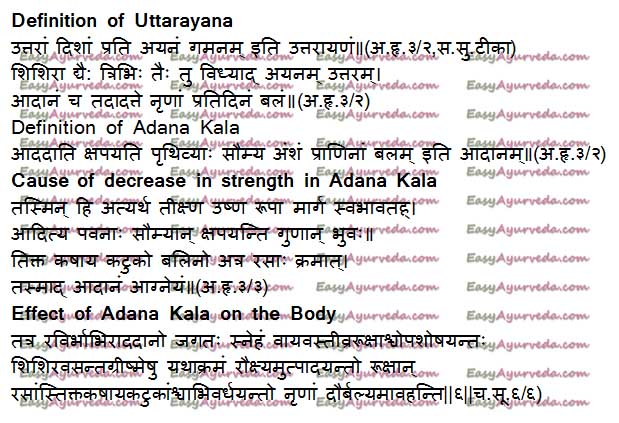Uttarayana – Adana Kala (Northern Solstice) Definition, Seasons, Effect On Health
Article by Dr Raghuram Y.S. MD (Ay) & Dr Manasa, B.A.M.S
Seasonal Regimen is all about the management of diet, lifestyle and behavior in relation to changing seasons as explained in Ayurvedic texts.
Seasons are classified into two main sectors of a calendar year i.e.
Uttarayana or Adana Kala (Northern Solstice) and
Dakshinayana or Visarga Kala (Southern Solstice).
Each Kala comprises of three seasons running through a period of 2 months. Therefore, each Kala has 6 months among which 2 months are allotted to each season.
Read related: Ritucharya – Healthy Seasonal Regimen – Introduction, Divisions
Table of Contents
Uttarayana
Uttarayana – Northern Solstice
Uttarayan is that part of the year in which there is ascent of the Sun. to be precise, in Uttarayan, there is northward movement of the Sun.

Definition of Uttarayana
According to Vagbhata, ‘The movement of the Sun in northern direction is called Uttarayana’
According to Vagbhata: ‘Uttarayana reduces the mild qualities from the Earth and takes away the strength of the human beings, hence depleting their strength and energy’
Definition of Adana Kala
Uttarayana is also called as Adana Kala i.e. the season which reduces the strength of human beings.
The three sesons included in Uttarayana Kala are –
- Shishira Rutu – Late Winter Season
- Vasanta Rutu – Spring Season
- Grishma Rutu – Summer Season
Since these seasons take away the strength of the human beings and reduce the mild qualities of the Earth, these three seasons are also called Adana Kalas. The Sun is predominant in the Adana Kala.
Effect on body
The impact of Sun and wind in Adana Kala over the Earth’s surface and Human Body
Cause of decrease in strength in Adana Kala
The intensity of the Sun is more and the wind is very dry during these three seasons (Shishira, Vasanta and Grishma), which reduce the mild properties of the Earth. Bitter, astringent and pungent tastes arepredominant in Shishira, Vasanta and Greeshma seasons respectively.
Effect of Adana Kala on the Body
During the Adana Kala, the intensity of Sun rays is high and strong. Apart from the Sun Rays, the wind also has sharp velocity and dryness. Both these together absorb the water content and the moisture from the Earth’s surface, making the Earth dry. Shishira, Vasanta and Greeshma, these three seasons have increased Tikta rasa, Kashaya rasa and Katu rasa respectively (i.e. the foods and medicines grown in these seasons will have the predominance of these tastes). These three tastes always tend to induce dryness in the body. When, due to the impact of dry season and consumption of these drying tastes, there is increased dryness in the body (owing to the depletion of water components of the body), there will be a reduction of the body strength naturally and consequentially.
Uttarayana Kala
Seasons of Adana Kala (Uttarayana Kala)
| Sl No | Name of the Rutu | Rasi (Zodiac) of the Sun | Saka varsa / masa (Hindu month) | Month | Predominant Rasa |
| 1 | Shishira
(Late Winter) | Makara (Capricorn)
Kumbha (Acquires) | Magha / Tapa
Phalguna / Tapasya | Jan15 – Feb15
Feb15 – March15 | Tikta (Bitter) |
| 2 | Vasanta
(Spring) | Meena (Pieces)
Mesha (Aeries) | Chaitra / Madhu
Vaisaka / Madhava | March15 –April15
April15 –May 15 | Kashaya (Astringent) |
| 3 | Greeshma (Summer) | Vrishabha (Taurus)
Mithuna (Gemini) | Jyeshta / Suci
Aashadha / Shukra | May15 – June15
June15 – July 15 | Katu (Pungent) |
Rutu, Strength and Taste
Relationship between the Rutu, strength and predominant taste
| Rutu | Raukshya (dryness) | Rasa | Panchabhuta | Bala Hrasa (deterioration in strength) |
| Shishira | Alpa (less) | Tikta | Akasha (ether, space) | Alpa (less) |
| Vasanta | Madhya (moderate) | Kashaya (Astringent) | Prithvi (Earth), Vayu (Air) | Madhya (moderate) |
| Grishma | (Pravara (more) | Katu (Pungent) | Agni (Fire), Vayu (Air) | Maha (severe) |
Actually when we analyze the tastes, astringent taste is drier in comparison to pungent taste. According to the predominance of taste, Vasanta Rutu is predominant in astringent and Greeshma Rutu is predominant in pungent taste.
According to the logic, Vasanta Rutu should be drier than Greeshma Rutu. But according to the tabular column (and actually) Greeshma Rutu, in spite of having Katu Rasa, is drier than Vasnta Rutu. The inference is that, Vasanta is Kapha Prakopa Kala (season for kapha aggravation). Therefore, the dryness brought by Kashaya Rasa is pacified by the moistness (fluidity) of Kapha. Thus Vasanta Rutu is Madhyama Ruksha or moderately dry in nature.
Other points of importance in relation to Uttarayana –
- At the ending part of Adana Kala i.e. Greeshma – summer, the strength of living beings will be less (alpa bala).
- The living beings will have moderate strength in the middle part of Adana Kala (madhyama kala) i.e. Vasantha – Spring Season
- At the beginning of Adana Kala i.e. Shishira – late winter season, the living beings will have comparatively good strength (uttama bala), but not as food as in Hemantha Rtu (winter).
- In the Adana Kala, the Sun will have its predominance and the climate will be hot. Due to the scorching heat of the Sun (adana), the universe will keep dry.
- During Shishira Rutu, foods with predominantly sour taste should be consumed.
- In Vasantha Rutu, dry, cold foods should be consumed.
- In Greeshma Rtu, sweet tastes can be adequately consumed.
- Kapha Chaya (accumulation) takes place in Shishira Rtu.
- Kapha Prakopa (aggravation) takes place in Vasantha Rutu.
- Kapha Prakopa and Vata Chaya (accumulation) takes place in Greeshma Rtu.
Click to Consult Dr Raghuram Y.S. MD (Ayu) – Email / Skype









